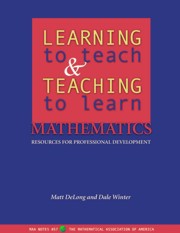Book contents
- Frontmatter
- Preface
- Contents
- 1 The Professional Development Program
- 2 How to Use this Book
- 3 An Orientation Session for the Beginning of the Semester
- 4 Making In-class Groups Work
- 5 Getting Students to Read the Textbook
- 6 Assessing and Evaluating Students' Work
- 7 Managing Homework Teams
- 8 Teaching During Office Hours
- 9 Establishing and Maintaining Control in Your Classroom
- 10 Proctoring Tests and Examinations
- 11 Teaching with Calculators and Computers
- 12 Making Lesson Plans
- 13 Strategies for Motivating Students
- 14 Dealing With Difficult Instructor-Student Situations
- 15 End-of-Semester Administration
- 16 Adapting Materials and Designing Your Own Meetings
- 17 Classroom Visits
- A Tips for Running Meetings
- B The Michigan Introductory Program
- Bibliography
13 - Strategies for Motivating Students
- Frontmatter
- Preface
- Contents
- 1 The Professional Development Program
- 2 How to Use this Book
- 3 An Orientation Session for the Beginning of the Semester
- 4 Making In-class Groups Work
- 5 Getting Students to Read the Textbook
- 6 Assessing and Evaluating Students' Work
- 7 Managing Homework Teams
- 8 Teaching During Office Hours
- 9 Establishing and Maintaining Control in Your Classroom
- 10 Proctoring Tests and Examinations
- 11 Teaching with Calculators and Computers
- 12 Making Lesson Plans
- 13 Strategies for Motivating Students
- 14 Dealing With Difficult Instructor-Student Situations
- 15 End-of-Semester Administration
- 16 Adapting Materials and Designing Your Own Meetings
- 17 Classroom Visits
- A Tips for Running Meetings
- B The Michigan Introductory Program
- Bibliography
Summary
A training program for new instructors will naturally begin with attention to day-to-day concerns. It is only after some familiarity and facility is achieved in these areas that a novice instructor has the opportunity for reflection on what is working in the classroom and why. One area for consideration at that point is the subject of student motivation.
An instructor's approach to student motivation will likely depend upon where he or she is situated on the pragmatist-idealist continuum. A total idealist would believe that the inherent beauty and power of mathematics should lead to intrinsic student motivation to learn the subject matter. A total pragmatist would maintain that the extrinsic motivation of grades alone determines a student's approach to mathematics. It would clearly be a superior situation if all students were intrinsically motivated to learn. This, unfortunately, is not the current reality of college mathematics courses, nor is it likely ever to be. In the absence of the ideal, an instructor must give careful consideration to the interplay between intrinsic and extrinsic motivators and the role that the instructor plays within each. Care must be taken, because under certain conditions extrinsic rewards can damage intrinsic motivation.
Student motivation is a complex and varied issue for which no one has all the answers. However, much can be learned by defining terms and comparing and contrasting possible approaches.
- Type
- Chapter
- Information
- Learning to Teach and Teaching to Learn MathematicsResources for Professional Development, pp. 159 - 168Publisher: Mathematical Association of AmericaPrint publication year: 2002
- 1
- Cited by



